Logto is an Auth0 alternative designed for modern apps and SaaS products. It offers both Cloud and Open-source services to help you quickly launch your identity and management (IAM) system. Enjoy authentication, authorization, and multi-tenant management all in one.
We recommend starting with a free development tenant on Logto Cloud. This allows you to explore all the features easily.
In this article, we will go through the steps to quickly build the OIDC enterprise SSO sign-in experience (user authentication) with iOS (Swift) and Logto.
Prerequisites
- A running Logto instance. Check out the introduction page to get started.
- Basic knowledge of iOS (Swift).
- A usable OIDC enterprise SSO account.
Create an application in Logto
Logto is based on OpenID Connect (OIDC) authentication and OAuth 2.0 authorization. It supports federated identity management across multiple applications, commonly called Single Sign-On (SSO).
To create your Native app application, simply follow these steps:
- Open the Logto Console. In the "Get started" section, click the "View all" link to open the application frameworks list. Alternatively, you can navigate to Logto Console > Applications, and click the "Create application" button.

- In the opening modal, click the "Native app" section or filter all the available "Native app" frameworks using the quick filter checkboxes on the left. Click the "iOS (Swift)" framework card to start creating your application.

- Enter the application name, e.g., "Bookstore," and click "Create application".
🎉 Ta-da! You just created your first application in Logto. You'll see a congrats page which includes a detailed integration guide. Follow the guide to see what the experience will be in your application.
Integrate iOS (Swift) with Logto
Add Logto SDK as a dependency
Use the following URL to add Logto SDK as a dependency in Swift Package Manager.
https://github.com/logto-io/swift.git
Since Xcode 11, you can directly import a Swift package w/o any additional tool.
We do not support Carthage and CocoaPods at the time due to some technical issues.
Carthage
Carthage needs a xcodeproj file to build, but swift package generate-xcodeproj will report a failure since we are using binary targets
for native social plugins. We will try to find a workaround later.
CocoaPods
CocoaPods does not support local dependency and monorepo, thus it's hard to create a .podspec for this repo.
Init LogtoClient
Initialize the client by creating a LogtoClient instance with a LogtoConfig object.
import Logto
import LogtoClient
let config = try? LogtoConfig(
endpoint: "<your-logto-endpoint>", // E.g. http://localhost:3001
appId: "<your-app-id>"
)
let client = LogtoClient(useConfig: config)
By default, we store credentials like ID Token and Refresh Token in the Keychain. Thus the user doesn't need to sign in again when he returns.
To turn off this behavior, set usingPersistStorage to false:
let config = try? LogtoConfig(
// ...
usingPersistStorage: false
)
Sign in
Before we dive into the details, here's a quick overview of the end-user experience. The sign-in process can be simplified as follows:
- Your app invokes the sign-in method.
- The user is redirected to the Logto sign-in page. For native apps, the system browser is opened.
- The user signs in and is redirected back to your app (configured as the redirect URI).
Regarding redirect-based sign-in
- This authentication process follows the OpenID Connect (OIDC) protocol, and Logto enforces strict security measures to protect user sign-in.
- If you have multiple apps, you can use the same identity provider (Logto). Once the user signs in to one app, Logto will automatically complete the sign-in process when the user accesses another app.
To learn more about the rationale and benefits of redirect-based sign-in, see Logto sign-in experience explained.
Configure redirect URI
Let's switch to the Application details page of Logto Console. Add a Redirect URI io.logto://callback and click "Save changes".

The Redirect URI in iOS SDK is only for internal use. There's NO NEED to add a Custom URL Scheme until a connector asks.
Sign-in and sign-out
Before calling .signInWithBrowser(redirectUri:), make sure you have correctly configured Redirect URI
in Admin Console.
You can use client.signInWithBrowser(redirectUri:) to sign in the user and client.signOut() to sign out the user.
For example, in a SwiftUI app:
struct ContentView: View {
@State var isAuthenticated: Bool
init() {
isAuthenticated = client.isAuthenticated
}
var body: some View {
VStack {
if isAuthenticated {
Button("Sign Out") {
Task { [self] in
await client.signOut()
isAuthenticated = false
}
}
} else {
Button("Sign In") {
Task { [self] in
do {
try await client.signInWithBrowser(redirectUri: "${
props.redirectUris[0] ?? 'io.logto://callback'
}")
isAuthenticated = true
} catch let error as LogtoClientErrors.SignIn {
// error occured during sign in
} catch {
// other errors
}
}
}
}
}
}
}
Checkpoint: Test your application
Now, you can test your application:
- Run your application, you will see the sign-in button.
- Click the sign-in button, the SDK will init the sign-in process and redirect you to the Logto sign-in page.
- After you signed in, you will be redirected back to your application and see the sign-out button.
- Click the sign-out button to clear token storage and sign out.
Add OIDC enterprise SSO connector
To simplify access management and gain enterprise-level safeguards for your big clients, connect with iOS (Swift) as a federated identity provider. The Logto enterprise SSO connector helps you establish this connection in minutes by allowing several parameter inputs.
To add an enterprise SSO connector, simply follow these steps:
- Navigate to Logto console > Enterprise SSO.
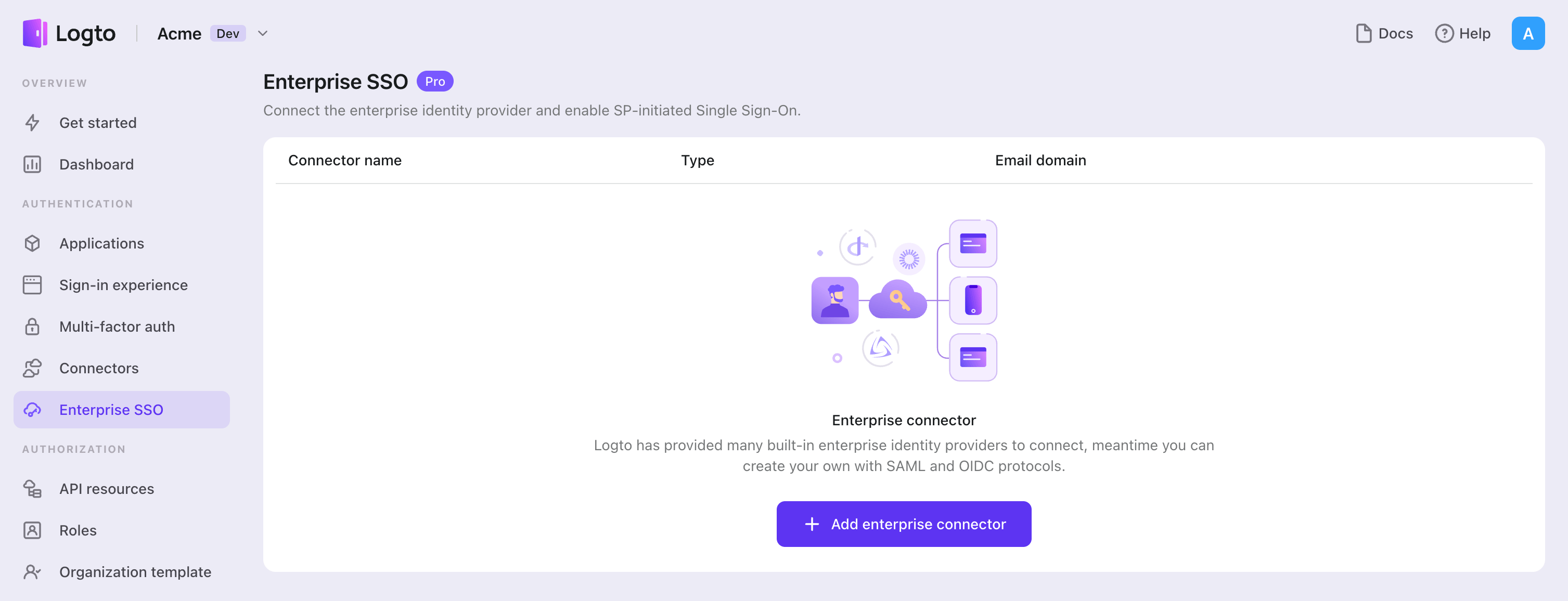
- Click "Add enterprise connector" button and choose your SSO provider type. Choose from prebuilt connectors for Microsoft Entra ID (Azure AD), Google Workspace, and Okta, or create a custom SSO connection using the standard OpenID Connect (OIDC) or SAML protocol.
- Provide a unique name (e.g., SSO sign-in for Acme Company).
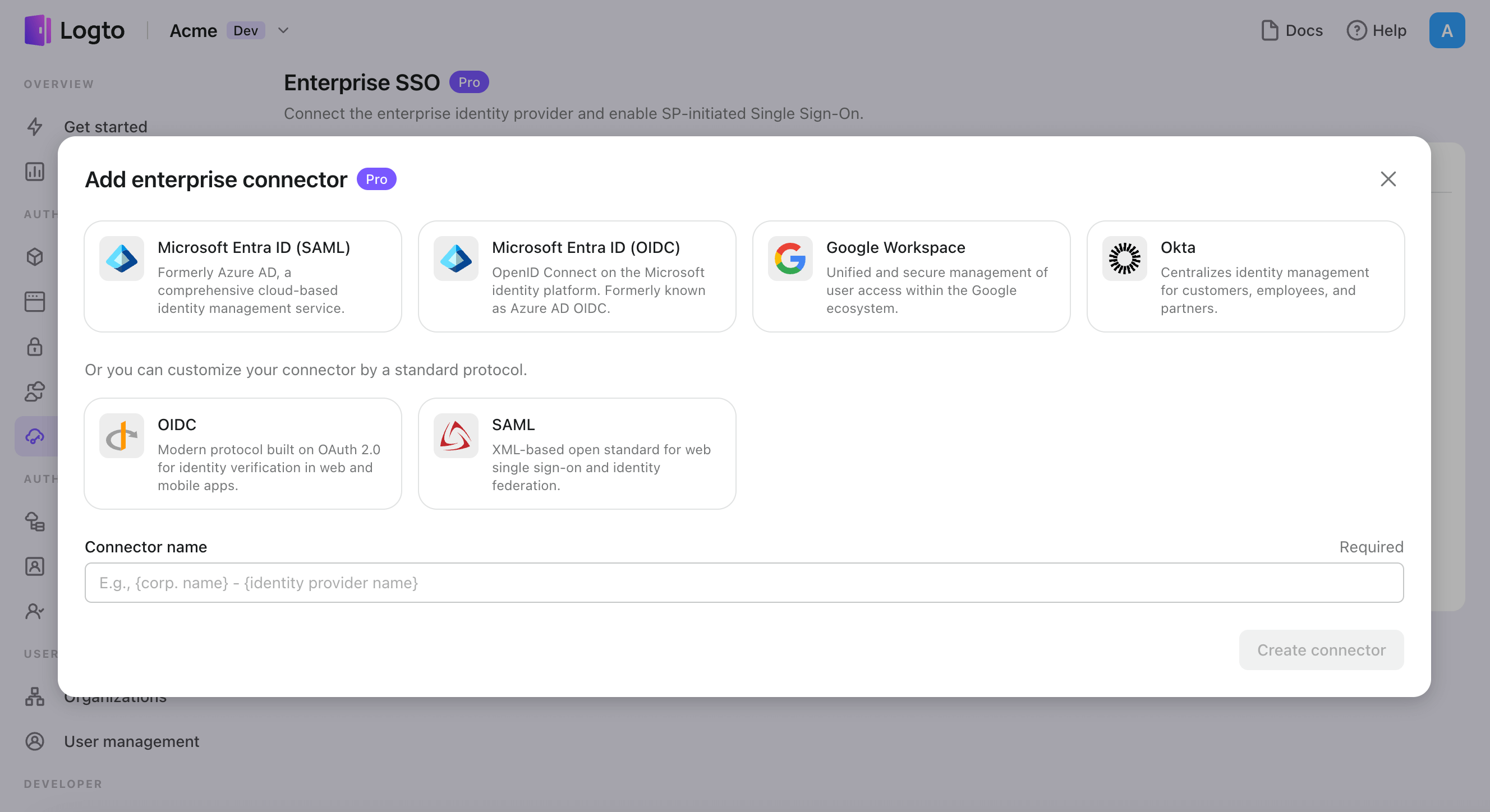
- Configure the connection with your IdP in the "Connection" tab. Check the guides above for each connector types.
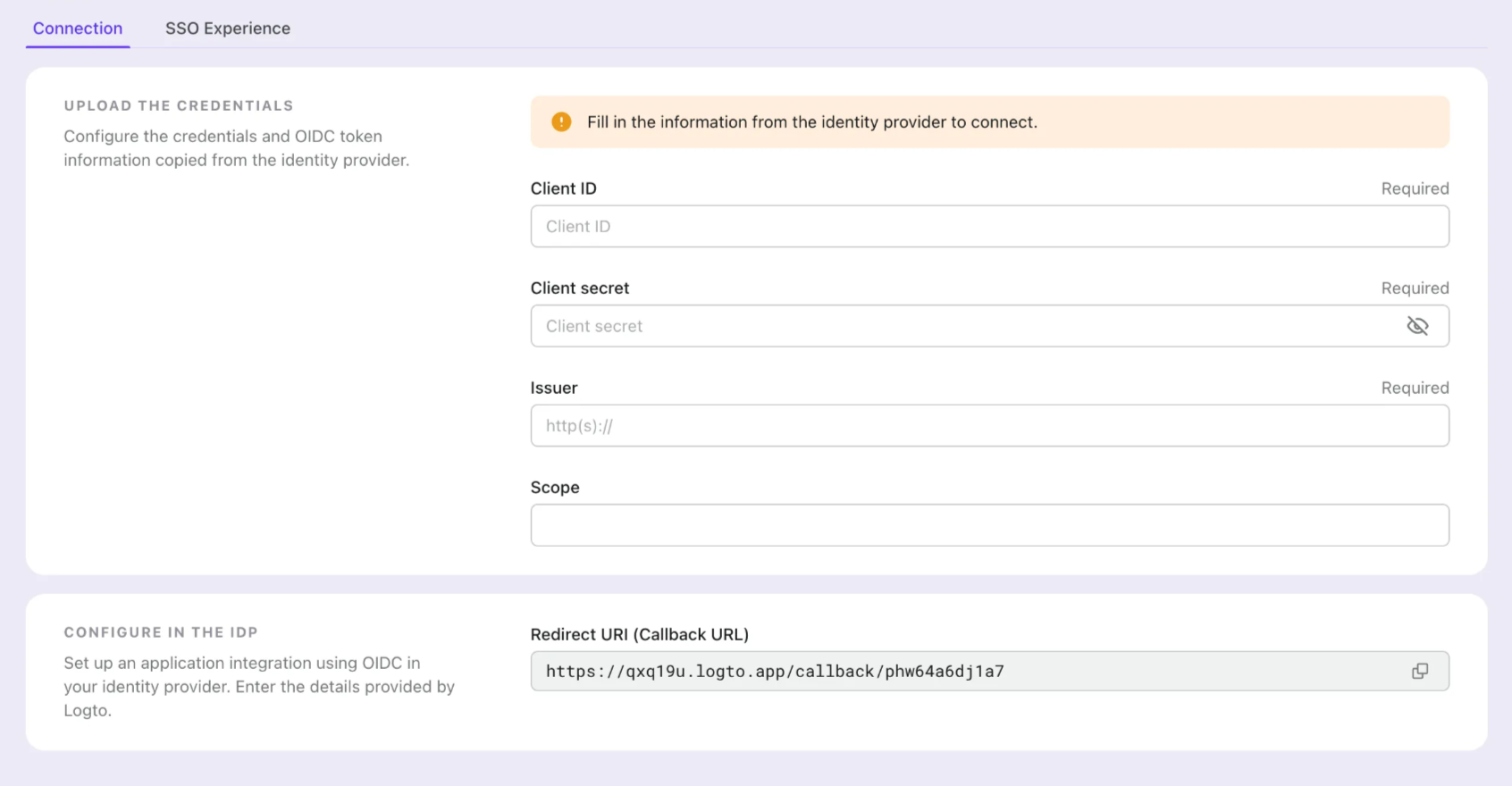
- Customize the SSO experience and enterprise’s email domain in the "Experience" tab. Users sign in with the SSO-enabled email domain will be redirected to SSO authentication.
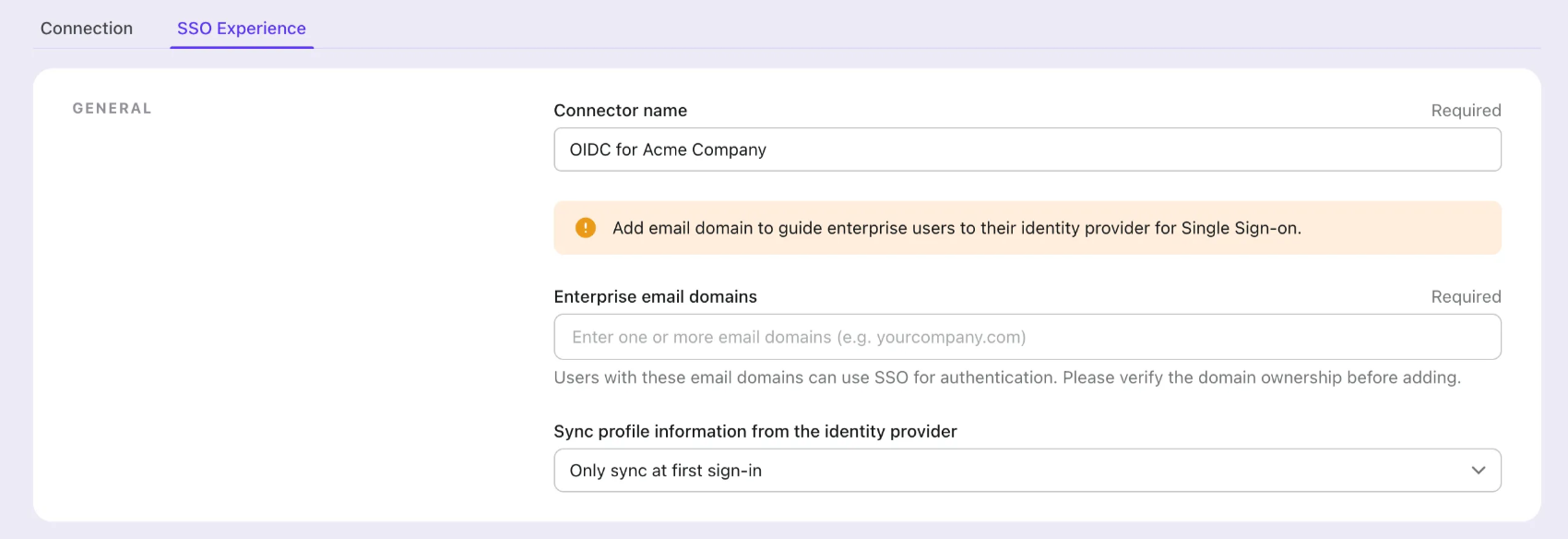
- Save changes.
Set up OIDC application on your IdP
Step 1: Create an OIDC application on your IdP
Initiate the OIDC SSO integration by creating an application on the IdP side. You will need to provide the following configurations from the Logto server.
- Callback URI: The Logto Callback URI, also known as the Redirect URI or Reply URL, is a specific endpoint or URL that the IdP uses to redirect the user's browser after successful authentication. After a user successfully authenticates with the IdP, the IdP redirects the user's browser back to this designated URI along with an authorization code. Logto will complete the authentication process based on authorization code received from this URI.
Fill in the Logto Callback URI in your IdP OIDC application settings form and continue to create the application. (Most of the OIDC IdPs provide a wide range of application types to choose from. To create a web-based SSO connector on Logto, please choose the Web Application type.)
Step 2: Configure OIDC SSO on Logto
After successfully creating an OIDC application on the IdP side, you will need to provide the IdP configurations back to Logto. Navigate to the Connection tab, and fill in the following configurations:
- Client ID: A unique identifier assigned to your OIDC application by the IdP. This identifier is used by Logto to identify and authenticate the application during the OIDC flow.
- Client Secret: A confidential secret shared between Logto and the IdP. This secret is used to authenticate the OIDC application and secure the communication between Logto and the IdP.
- Issuer: The issuer URL, a unique identifier for the IdP, specifying the location where the OIDC identity provider can be found. It is a crucial part of the OIDC configuration as it helps Logto discover the necessary endpoints. To make the configuration process easier. Logto will automatically fetch the required OIDC endpoints and configurations. This is done by utilizing the issuer you provided and making a call to the IdP's OIDC discover endpoints. It is imperative to ensure that the issuer endpoint is valid and accurately configured to enable Logto to retrieve the required information correctly. After a successful fetch request, you should be able to see the parsed IdP configurations under the issuers section.
Step 3: Configure scopes (Optional)
Scopes define the permissions your app requests from users and control which data your app can access from their enterprise accounts.
Setting up scopes requires configuration on both sides:
- Your Identity Provider (IdP): Configure which permissions are allowed for authorization in your IdP console
- Some IdPs enable all public scopes by default (no action needed)
- Others require you to explicitly grant permissions
- Logto enterprise connector: Specify which scopes to request during authentication in the Logto OIDC enterprise connector settings >
Scopesfield.- Logto always includes the
openid,profile, andemailscopes to retrieve basic user identity information, regardless of your custom scope settings. - You can add additional scopes (separated by spaces) to request more information from the IdP.
- Logto always includes the
If your app needs to access APIs using these scopes, make sure to enable Store tokens for persistent API access in your Logto enterprise connector. See the next section for details.
Step 4: Store tokens to access third-party APIs (Optional)
If you want to access the Identity Provider's APIs and perform actions with user authorization, Logto needs to get specific API scopes and store tokens.
- Add the required scopes in the scope field following the instructions above
- Enable Store tokens for persistent API access in the Logto OIDC enterprise connector. Logto will securely store access tokens in the Secret Vault.
- For standard OIDC identity providers, the
offline_accessscope must be included to obtain a refresh token, preventing repeated user consent prompts.
Step 5: Set email domains and enable the SSO connector
Provide the email domains of your organization on Logto’s connector SSO experience tab. This will enable the SSO connector as an authentication method for those users.
Users with email addresses in the specified domains will be redirected to use your SSO connector as their only authentication method.
Save your configuration
Double check you have filled out necessary values in the Logto connector configuration area. Click "Save and Done" (or "Save changes") and the OIDC enterprise SSO connector should be available now.
Enable OIDC enterprise SSO connector in Sign-in Experience
You don’t need to configure enterprise connectors individually, Logto simplifies SSO integration into your applications with just one click.
- Navigate to: Console > Sign-in experience > Sign-up and sign-in.
- Enable the "Enterprise SSO" toggle.
- Save changes.
Once enabled, a "Single Sign-On" button will appear on your sign-in page. Enterprise users with SSO-enabled email domains can access your services using their enterprise identity providers (IdPs).
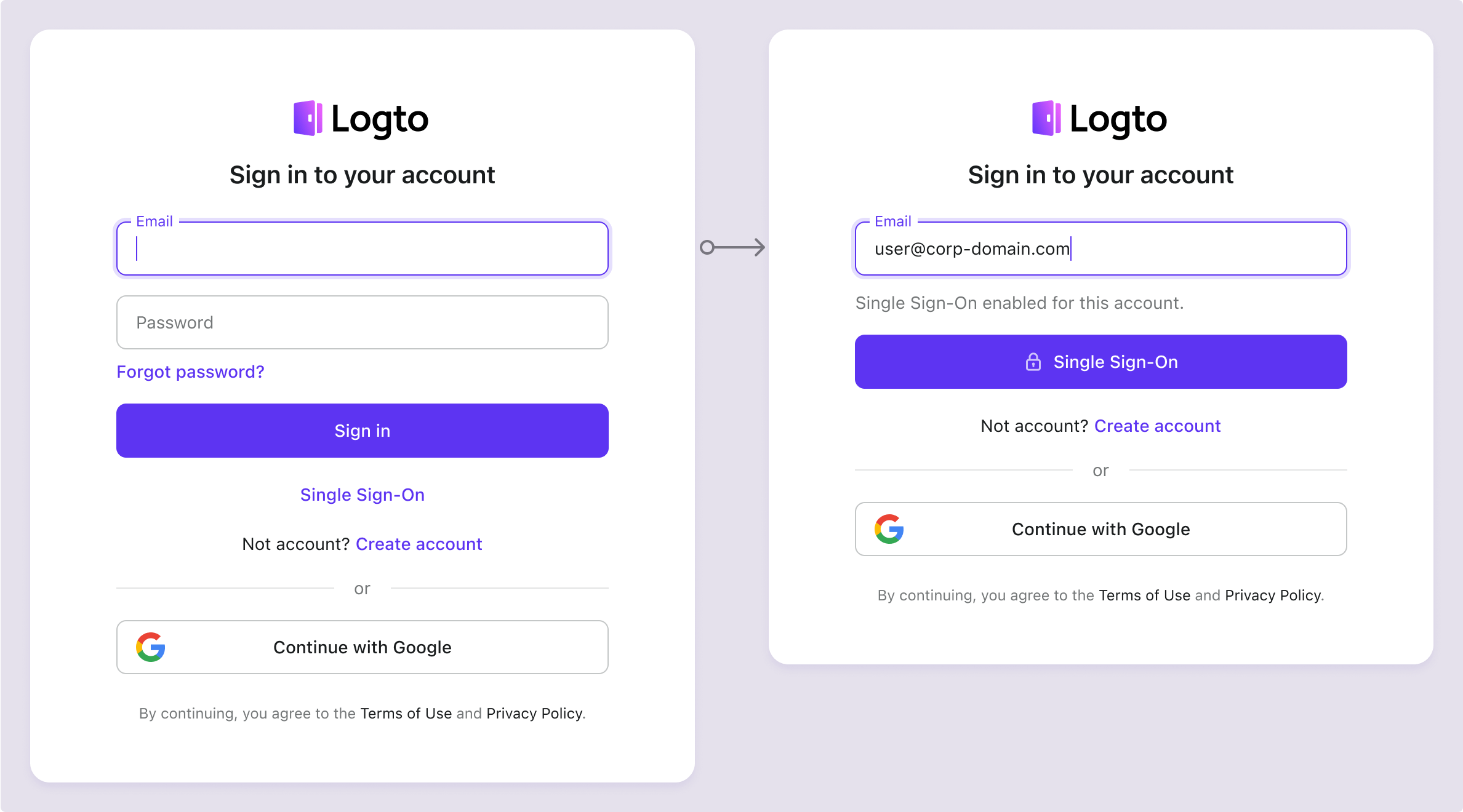
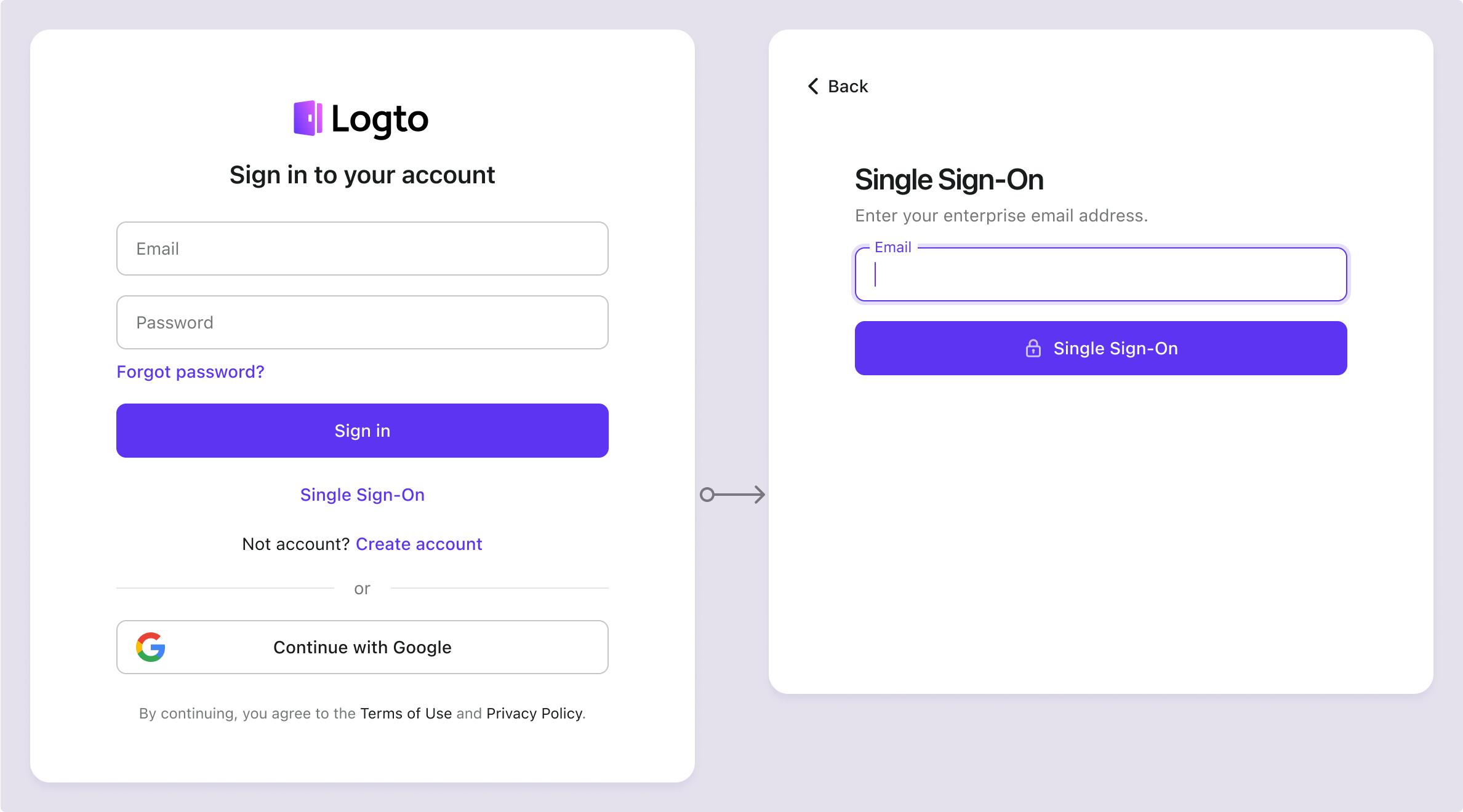
To learn more about the SSO user experience, including SP-initiated SSO and IdP-initiated SSO, refer to User flows: Enterprise SSO.
Testing and Validation
Return to your iOS (Swift) app. You should now be able to sign in with OIDC enterprise SSO. Enjoy!
Further readings
End-user flows: Logto provides a out-of-the-box authentication flows including MFA and enterprise SSO, along with powerful APIs for flexible implementation of account settings, security verification, and multi-tenant experience.
Authorization: Authorization defines the actions a user can do or resources they can access after being authenticated. Explore how to protect your API for native and single-page applications and implement Role-based Access Control (RBAC).
Organizations: Particularly effective in multi-tenant SaaS and B2B apps, the organization feature enable tenant creation, member management, organization-level RBAC, and just-in-time-provisioning.
Customer IAM series Our serial blog posts about Customer (or Consumer) Identity and Access Management, from 101 to advanced topics and beyond.